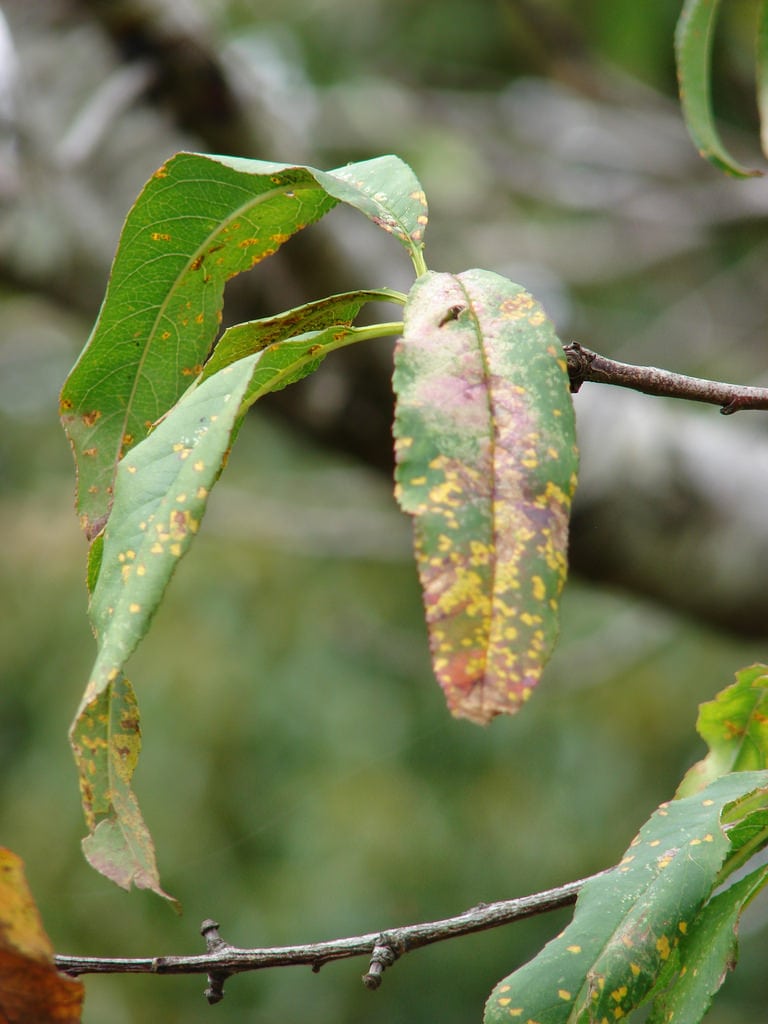Peach Rust Info: Learn How To Treat Peach Rust In The Garden


Growing peaches is a delight if you love this tasty fruit, but if you see the signs of rust disease you could lose your harvest. This disease is less of an issue in cooler climates, but if you are growing peaches somewhere like Florida or California, be aware of peach rust, what it looks like, and how to manage or treat it.
Peach Rust Info
If you’re wondering what causes peach rust, it is a disease caused by a fungus, Tranzschelia discolor, that spreads through the air via spores and depends on moisture to spread, grow, and cause an infection. Wet, warm conditions make peach trees more susceptible to rust disease, especially when water, either from rain or irrigation, remains on leaves for too long. The earliest sign of peach rust is the formation of cankers on twigs in spring. They occur right after petals drop and look like blisters but are small and not easy to spot. Easier to see are the lesions that form next on leaves. They are yellow on the upper parts of leaves and reddish brown spores on the lower leaves. The latter gives the disease its name, as the spores resemble rust. Fruit lesions are small brown spots that turn green to yellow as the peaches ripen. Preventing Peach Rust The best method of peach rust control is prevention. Keep leaves dry by avoiding overhead irrigation and splashing water up onto branches and leaves, giving trees plenty of space for air flow, and pruning regularly for air flow between branches. These measures are especially important in warmer climates and where there is a lot of rain, as is monitoring trees to catch signs of an infection as early as possible.
How to Treat Peach Rust
Treating peach rust means using fungicide to destroy the fungus and spores. In some areas, such as cooler climates and where there is not too much rain, a light infection may not require treatment. It will not necessarily cause a lot of damage. However, if your climate is warm and humid, treating early can help prevent a serious infection. Treating severe peach rust is not always effective. For fungicide, or sulfur treatments for organic gardening, to be effective, you need to spray trees in the spring, before signs of the disease show on the leaves. Look early in the spring for cankers on twigs and if you see them you can try to nip the disease in the bud by spraying as soon as leaves emerge.
Gardening tips, videos, info and more delivered right to your inbox!
Sign up for the Gardening Know How newsletter today and receive a free copy of our e-book "How to Grow Delicious Tomatoes".

Mary Ellen Ellis has been gardening for over 20 years. With degrees in Chemistry and Biology, Mary Ellen's specialties are flowers, native plants, and herbs.
-
 Creative Ideas For Plant Containers: 7 Ways To Save Money And Add Charm To A Garden
Creative Ideas For Plant Containers: 7 Ways To Save Money And Add Charm To A GardenIf you are looking for great ways to add personality to your container gardening – and even save yourself some money – then try these creative ideas for plant containers
By Mary Ellen Ellis
-
 How To Make A Bouquet Garni Or Herb Bundle For Cooking
How To Make A Bouquet Garni Or Herb Bundle For CookingIf you’re a great cook, you may have made an herb bundle before. If this is a new idea, learn how to add sparkle and interest to your dish with a bouquet garni.
By Amy Grant